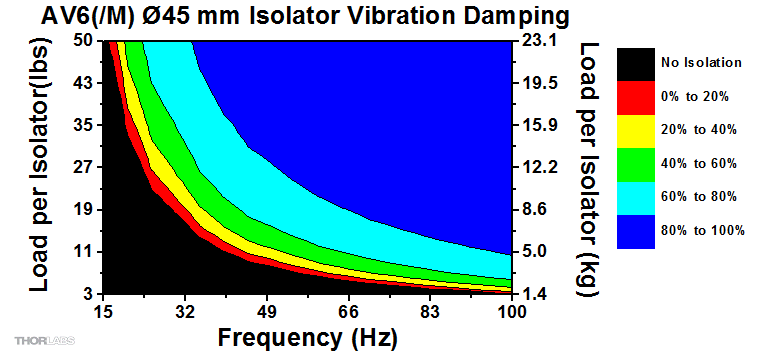Thanks for the reply, Thomas! I do not have any frequency specific data. I reviewed the manufactures claims, and they state, "absorbs 94.7% of vibration", not the 96 i previously stated. Thats at 1" hemisphere with a durometer of 50 (they have hemispheres up to 2" on their site). 6 of those would have a rating of 24lbs, the same as my monitors, eve audio sc208's
As Thomas pointed out (Hi Thomas! Welcome back!!!

), it's not as easy as that. And manufacturer's claims should be taken with a large grain of salt!
That said, I do use Sorbothane pads (not the hemispheres!) in my speaker mount designs, but it's a real pain to get it right: As the graph posted by Thomas show, you need to get a lot of weight on the pads in order to get the frequency down low enough... but you also have to ensure that you don't over-compress (or more accurately "over deflect") the rubber, as that will trash your isolation too.
Also, do take into account that in acoustics, we don't often talk about isolation in terms of "percent", as that's misleading. It's more common to talk about it in decibels. I always get skeptical when I see isolation claims specified in percentages, as it is easy to mislead like that. Someone who claims their product "stops 75% of sound" is not saying much at all! It sounds like a LOT, but it rally isn't. If your car fuel tank is 75% full, you have plenty of fuel, but if your speaker isolator gives 75% transmission loss, that's pretty poor. This conversion scale might help illustrate:
dB-to-percentage-conversion.jpg
It's the reciprocal of 94% that you want here, so look at the 6 percent mark on that graph: it's about 24 dB. So if you could tune your mounting system to isolate across the full audio spectrum according to that 94% figure, you'd be getting 24 dB reduction. And that's assuming that you really do get 94%! If it turns out to only be 85%, then the reduction is more like 15 dB.
But what does that even mean? The isolation is different for every frequency on the spectrum, so when they say "94%", do they mean at 100 Hz? Or at the resonant frequency? Or maybe one octave higher? Or 4 octaves higher? They don't say, so you can only guess...
Saying that a product "isolates 94%" is basically meaningless, unless that is qualified with more data.
For example, lets' assume that the 94% figure is true for a tone of 1 kHz. But isolation rolls off ever more steeply at lower frequencies, for reasons that are a bit complex to go iot here (but you can see that on the graph Thomas posted), so even though the product might really provide 94% isolation at 1 kHz, it very surely will not be 94% at 100 Hz! Maybe 80%, with luck... And at 50 Hz, it will be far worse... The isolation gets worse, the lower you go.
You also need to factor in your cross-over (assuming you are using a sub). You might think that because you have a sub, your mains are not sending out any low frequencies, and all of the lows will be coming only from the sub. But that's not correct. For example, if you have your cross-over set to 80 Hz, that does not mean that your main speakers stop dead cold at 79 Hz! They are still emitting abundant sound down to much lower frequencies. Your SC-208's are spec'd to get down to 36 Hz (-3dB), so they are very much capable of putting out a lot of energy at low frequencies, even considering the cross-over. Let's say your cross-over is second-order: it's rolling off 12 dB per octave, so at 40 Hz (one octave below the cross-over point) the level is only 12 dB down: still quite a lot of energy there. Even if you use a fourth-order cross-over, rolling off at 24 dB per octave, that still allows a fair amount of power output at 40 Hz, or 30 Hz, or even 20 Hz. And it's the vey low frequencies where vibration becomes a big issue.
In other words, if you go with a resilient mount, you need to ensure that the isolation system is tuned way lower than the bottom end of the speaker's spectrum, even if you use cross-overs, or else the speaker could still be transmitting substantial vibration into the soffit structure.
Considering the cutoff frequency of the baffle step at 447hz,
The baffle step response is not related to the speaker cut-off frequency. Baffle step is about something else entirely: it's the frequency where the front panel of the speaker stops acting like an infinite baffle, and sound can start "wrapping around" behind the speaker.. And it's not really a "cutoff" either: more like a "roll-off". But either way, the baffle step response does not influence what you are trying to accomplish with the mounting system. In simple terms, your mount must either be tuned so that it provides sufficient isolation at least an octave below the lowest frequency that your speaker will be producing in order to not transmit excessive vibration into the soffit structure, or it must be rigid, solid, and massive enough to be able to handle that energy transfer without vibrating.
- Stuart -

